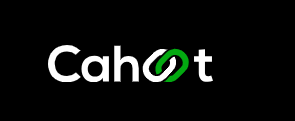Maximize Amazon Conversion in Q4
Advice from SellerApp and Cahoot
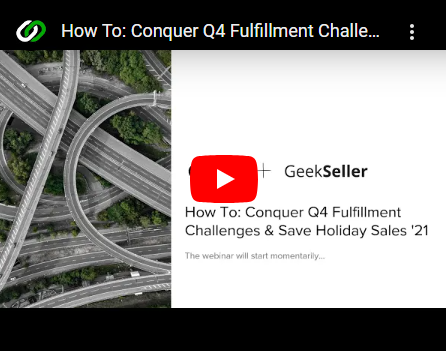
We’ve been advising our clients to start their holiday sales early this year, but we didn’t realize just how far Amazon would push the envelope. If you haven’t noticed, they changed their site over to emphasize Black Friday-worthy deals on October 4th – just two business days into Q4!
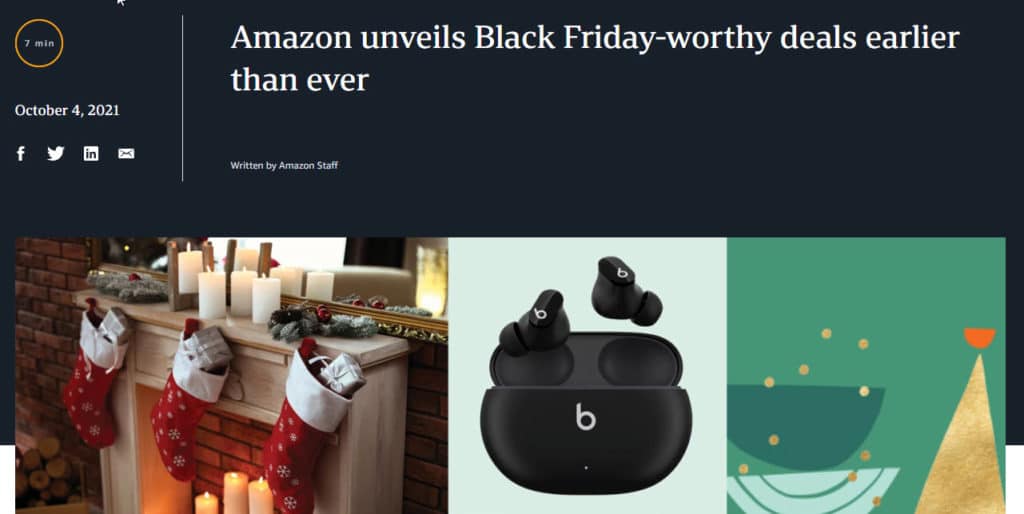
Amazon saw that people are starting and finishing their holiday shopping earlier and earlier every year, so they decided to make a bold move to define a new normal. They’ve done it before, and we won’t bet against them.
You shouldn’t leave the fun to Amazon – the earlier you start your holiday selling, the better. The benefits are twofold: one, you’ll extend your holiday season and increase revenue, and two, that early revenue will be more profitable.
Early selling relies on a unified demand generation and operations strategy. You need to load up on products much earlier than you’re used to, and you’ll need to make sure that your fulfillment options can keep up with the surge. With that operational excellence in hand, you can turn on the advertising spigot earlier to reap the rewards. On the operations side, you’ll save money by beating spikes in shipping costs and surcharges, and for advertising, you’ll save by advertising while others aren’t yet piling extra money into PPC.
Read on for Q4 advertising advice from Dilip Vamanan, co-founder of SellerApp, and fulfillment advice from Manish Chowdhary, founder of Cahoot; apply what you’ve learned for your biggest, most profitable Q4 yet.
Basics of PPC
Dilip opened his advice by going back over the basics – even for experienced sellers, it’s helpful to review the foundations of the business every once in a while.
Bid calculator for Amazon PPC
After you review your COGS and other expenses, you’ll know how much margin you have left to work with for advertising. The portion of margin that you devote to PPC is your Average Cost of Sale, or ACoS).
Your PPC bid, then, will be determined by your Conversion Rate, your Revenue per Conversion, and your target Average Cost of Sale.
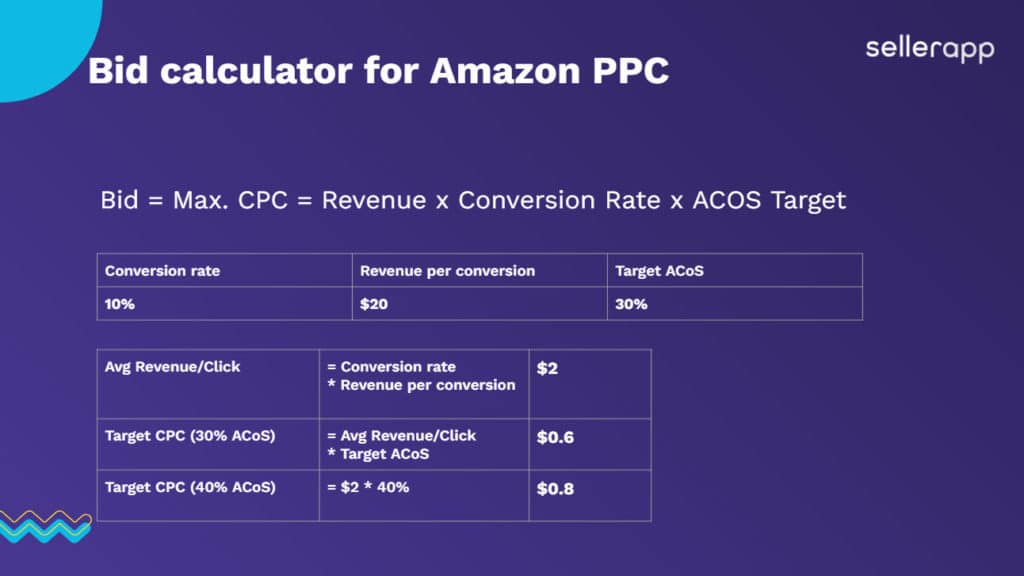
Multiply Conversion Rate x Revenue x ACoS, and there you have it – your target Cost per Click. The math may be simple, but of course the decision on what your ACoS should be is a bit more difficult. To help, Dilip shared his expertise on how to think about advertising budgets for three different common scenarios.
Scenario 1: Product Launch
Your goal is to get a product up off of the ground, so you want an aggressive advertising strategy. To start, you could even aim just for break even – an ACoS that results in a 0% profit margin for the product.
This approach will drive huge amounts of impressions and clicks, which will generate momentum and help your product to start ranking well. The initial surge from your aggressive advertising will result in plenty of sales (if you’ve optimized the listing well), which then starts to generate organic traffic. Once you’re seeing more serious organic traffic and your product is rising in the search ranks, you can start to dial back your advertising budget.
If you look for profit right off the bat, Dilip relates, “we’ve seen many products fail due to this [conservative strategy]. Amazon is a place where you need to generate initial sales velocity for the Amazon algorithms to see and like the product”.
Scenario 2: Brand Loyalty
What if you’re more focused on a brand than a specific product? You need a sponsored brand campaign that pulls together a few of your best-selling products. With this broader approach, people will start to recognize your brand, which can generate brand-specific searches. Moreover, it’s not an either-or: you can (and should) run brand campaigns and product-specific campaigns.
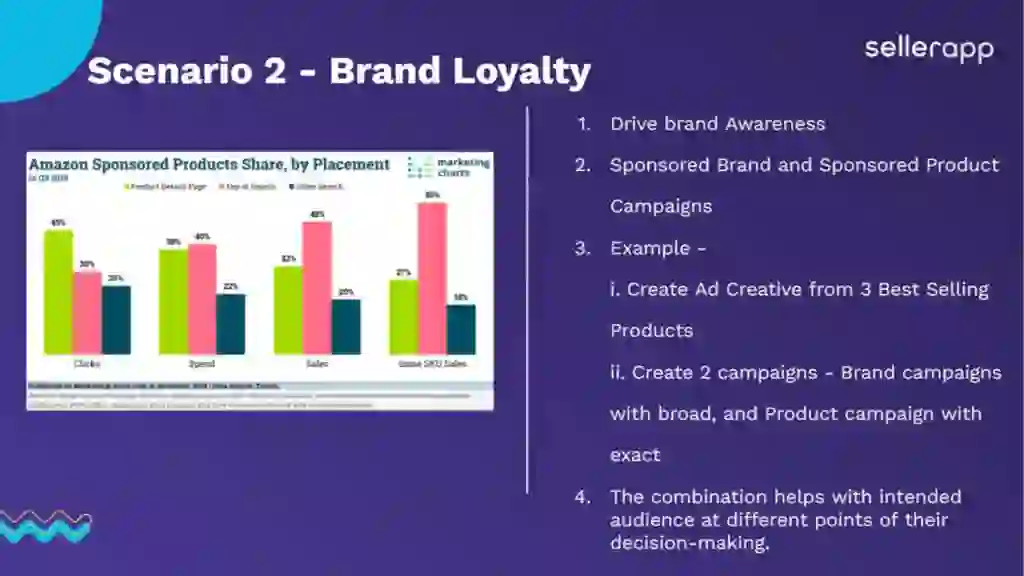
Brand campaigns are best suited for earlier in the funnel, when prospective customers are making more general searches. While they’re “just browsing”, or thinking through a potential purchase, your brand campaign can leave a positive impression for when they come back later with a more specific search. So aim these at the Top of Search, while your product-specific ads can aim at Product Details Pages and other more conversion-focused locations.
Scenario 3: Remarketing
Remarketing is for maximizing sales from your specific niche. It’s more valuable once your products are in decent shape on search pages – you’ll get the most bang for your buck if they’re already generating a significant number of impressions.
Consider that decision time frame of your product; if it’s a very fast purchase, then remarketing isn’t for you. But for a larger purchase, remarketing can be a vital tool – customers that click, add to cart, and then abandon aren’t necessarily lost. They could just be making a decision over a few weeks, in which case remarketing can grab them when they come back more ready to buy.
A low ACoS display campaign that is very narrowly targeted at returning users can be an effective way to boost conversion. Here, Amazon DSP can also be helpful. It enables you to target specific users outside of Amazon.com, giving them that extra nudge towards returning to your product page and buying.
Importance of Advertising Automation
Dilip walked our audience through a simple math problem – the more successful you become, the more time you have to spend optimizing each aspect of your advertising campaigns. And not only will you have more campaigns, but they’ll also be more complex.

Automation will not only cut down on the time you have to spend managing the minutiae of advertising; it will also make your advertising more effective. In fact, Dilip relates four key benefits:
- Saves time
- Delivers insights
- Contextualizes decisions
- Stores history
A smart automation tool will remember what worked in old campaigns and will deliver up insights and recommendations to improve the campaigns of the future. Amazon itself only stores data for 180 days, so if you want to learn from the previous holiday season, for instance, you’ll be out of luck if you’re depending entirely on Amazon. Create an initial strategy, and then let an automation platform learn for you and iterate from there.
Using a Keyword Harvester
A keyword harvester is a fantastic automated tool that helps you scale. Dilip walked the audience through a common example that he sees – you’ve had some success, you have a bunch of successful keywords, and you want to seriously increase the number of keywords you’re bidding on to scale.
Enter the keyword harvester – it will learn from what’s worked for you so far and what’s worked for others, and automatically start bidding on related keywords to increase volume. It’s a “just add water” tool that can instantly boost your results.
Amazon Ad ROI Optimizer
Where the keyword harvester is focused on growth, an ROI optimizer is all about profitability.
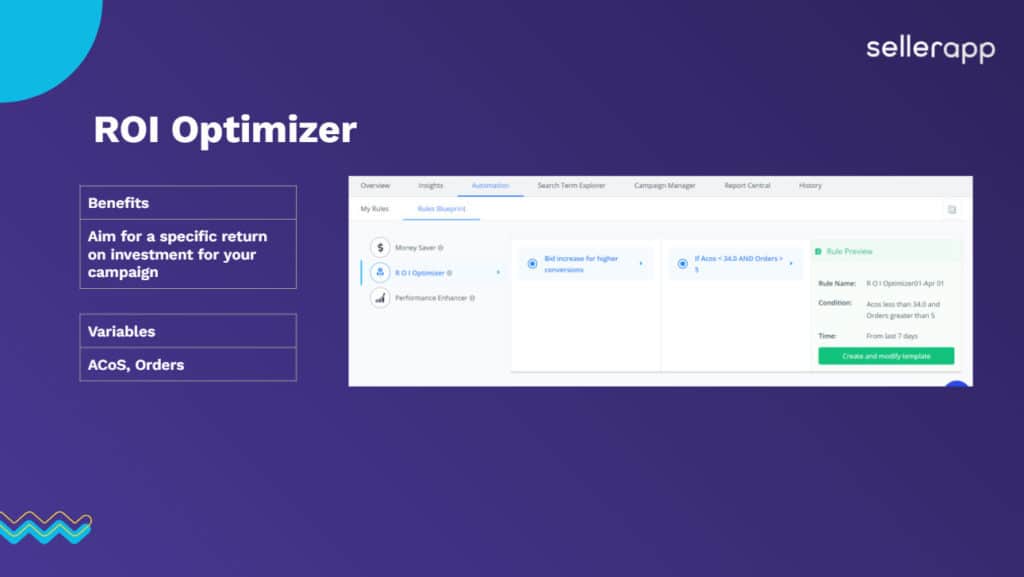
With an ROI optimizer, you can specify ACoS for each campaign, ensuring that you’ll never miss a profit number. You can add sophistication by bringing in other variables such as time of day, number of orders converted within a day, and more. This way, you can run a campaign at a high ACoS on certain days or during time of days when you know conversion is high, and then throttle it during less lucrative times. This also can help you manage inventory – if you’ve sold a certain number of items in a day, the tool can automatically change ACoS to slow down impressions to the product.
Money Saver
Who doesn’t want to save money? The Money Saver is the perfect tool to slice out keywords that you specifically don’t want to bid on, or “negative keywords”.
Keep an eye on keywords that seem like they could be good fits for your products, but have low conversion. This often happens within product families, where a small change in search term seems innocuous, but actually shows specific intent by a searcher. You may be selling tents, for instance, but if you don’t sell every type of tent, then you should use negative keywords to specifically block bidding on them. This will prevent you from wasting money on clicks that never had a chance of converting.
Q4 Last Minute Ad Improvements
For this Q4, Dilip shared some tips with the audience that they can quickly implement to boost returns.
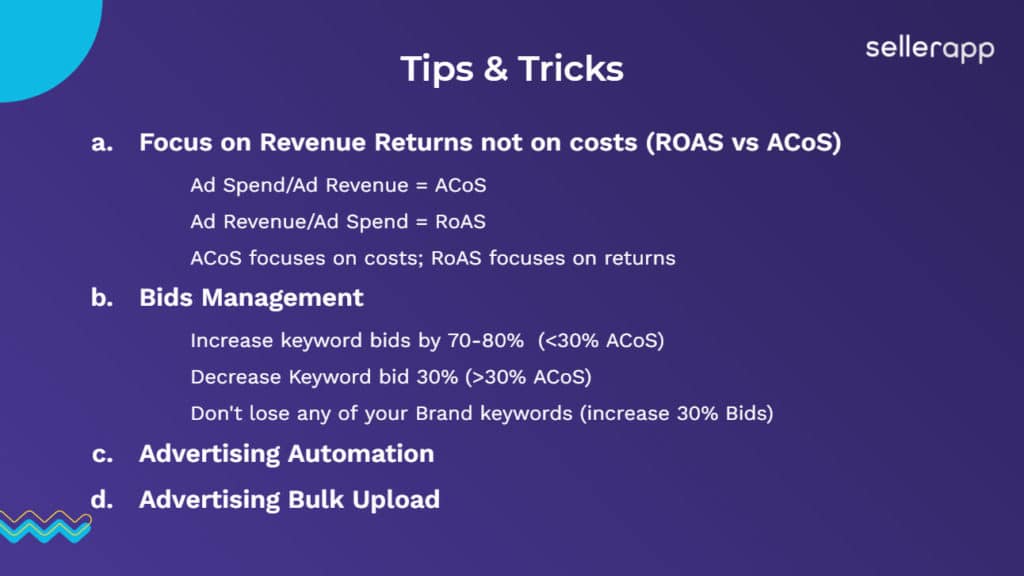
First, make sure that your mindset is about generating revenue, and less about minutely managing costs. This can be as simple as looking at your ad profitability as Ad Revenue / Ad Spend (RoAS), instead of Ad Spend / Ad Revenue (ACoS). If you’re getting a healthy return on your ad spend in Q4, don’t worry too much about an ACoS that looks a bit worse than it does in other quarters. Huge volume multiplied by slightly lower profitability results in more profit than moderate volume with slightly higher profitability, and the best sellers recognize that in Q4 the potential for huge volume is there.
Next, for keywords that are profitable, increase your bid by 70-80% to ensure that you get holiday impressions. To pay for this, shut off all of the keywords that you’ve been testing that just aren’t working for you. And make sure that you don’t lose your Brand keywords – competitors will come for them, and they will take away sales if you’re not defending them. Increasing by 30% should be enough to ward off the worst effects of competitive pressure.
Remember that Amazon has enabled a bulk upload tool that can save you a lot of time to make these changes. It’s right in Seller Central, and you can use it to make mass adjustments like the ones listed above.
The earlier you get aggressive, the more you’ll be able to protect margin while driving volume. Your competitors will put massive amounts of dollars into the same keywords that you target during Q4, and especially from mid-November onwards, so if you start in October (like Amazon did), then you’ll be able to raise your bids more granularly. Your October and early November volumes will increase significantly while margin holds up, and then margins will thin as you get into the teeth of the holiday season.
Beat the Parcel Carrier Crunch
In case you need more convincing, take a peek at growth in US spending on goods in 2020 and 2021 – we haven’t seen growth like this for more than 70 years.
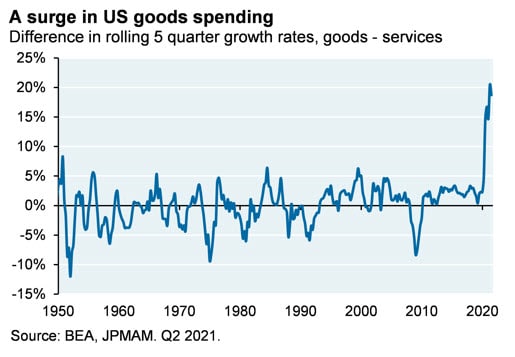
This means that you have to throw out your old concept of ‘good times to sell’. The reality is, October of 2021 is seeing good spending similar to holiday seasons of just a few years ago thanks to the huge growth in overall spending. There’s a ton more volume out there for you to capture. On top of that, the sooner in Q4 you capture revenue, the more profitable it is.
Quantifying the Cost to eCommerce Merchants
Major carriers take advantage of the rush in holiday demand with surcharges. Note when they start – FedEx’s will begin on November 1st, and then they double on November 28th. UPS’ surcharges kick in on October 31st and November 15th. Only USPS is ahead of the curve, with surcharges that started on October 3rd.
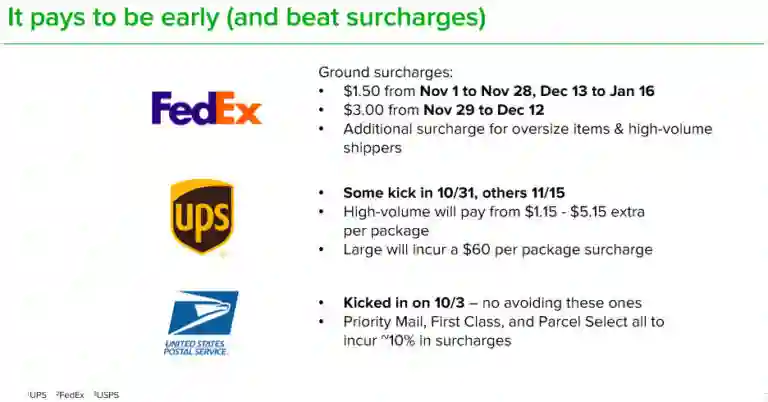
The earlier you sell in Q4, the less you’ll pay in surcharges. How much margin does a $1.50 per package charge eat up for your best sellers? How about $3.00 per package?
The capacity crunch also negatively impacts your customer experience. Shoppers are extra sensitive to receiving packages in time for big gifting days, so delays are particularly punishing for sellers. Too bad, then, that December is the worst time of year for delays. The sooner you sell, the less fulfillment will cost you, and the happier your customers will be.
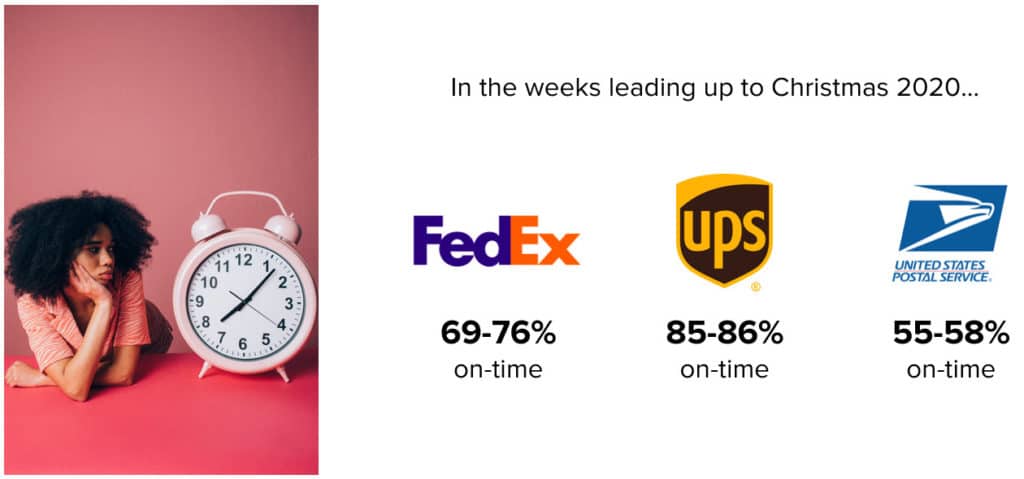
Distributed eCommerce Fulfillment Mitigates Crunch
By selling early, you can avoid the worst of the crunch, but we know that you’re going to keep selling for the entire holiday season. You’ll need a way to mitigate the worst fulfillment challenges.
A distributed nationwide eCommerce fulfillment network answers your needs by unlocking fast and affordable shipping. Distributed fulfillment is also less risky by design, as if one area of the country is particularly congested, you always have another region ready to take over.
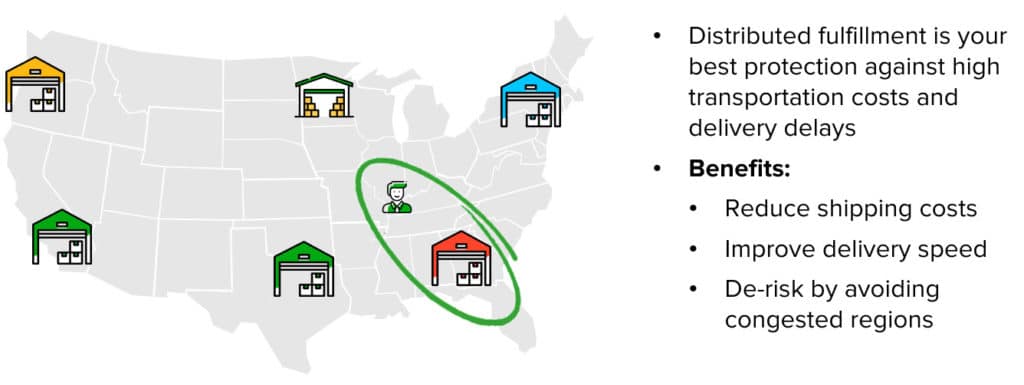
The approach strategically places inventory across the country so that no matter where the customer is, there’s always a fulfillment center nearby. With this strategy, you can always get products to the customer’s doorstep in 1 to 2 days, but you’ll do it with cheap ground shipping rates. This is how FBA offers such low fulfillment fees, but as we’ve detailed above, it’s an incomplete solution at best. You’ll need Amazon FBM to unlock your growth potential for Q4 and beyond.
Overcome FBA Limits with Amazon FBM
Your big push will fall flat if you can’t fulfill orders, and unfortunately, Amazon FBA is becoming less and less reliable. Most FBA sellers are in the same boat that you are, fighting inventory limits and receiving delays. You’re wondering – if Amazon is having this much trouble with my inventory now, can I rely on them during the holiday season?
You definitely can’t – they just don’t have space. Take a look at their fulfillment investment plan, pictured below.
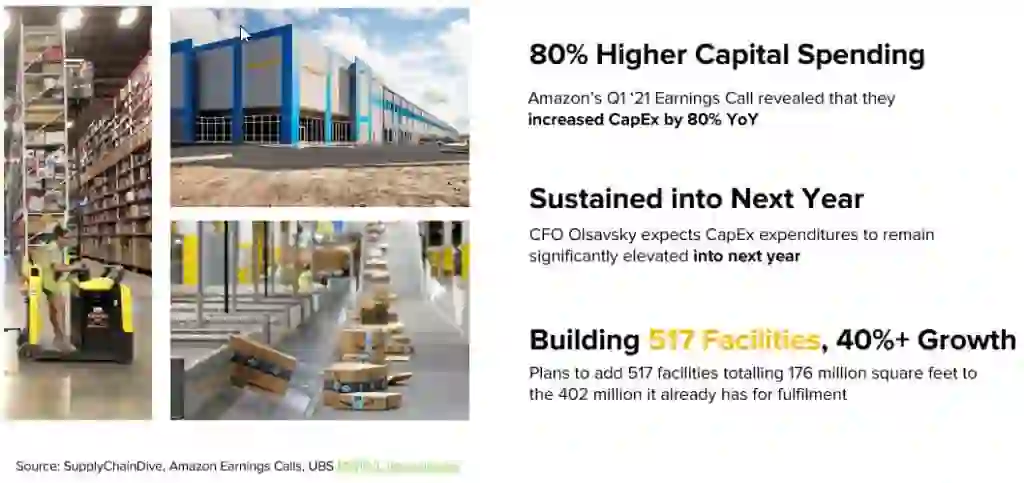
They’ve boosted supply chain CapEx to historically high levels, but they’re still behind and have multiple years of multi-billion-dollar spending on fulfillment capacity to keep up. This Q4, you won’t be able to depend on them.
To keep this simple, we have one overriding piece of advice: don’t go out of stock. Going out of stock triggers a vicious cycle that torpedoes your sales rank and sell through rate, which then hurts your IPI, which further kills your inventory limits. One stockout during Q4 will dramatically depress results for the rest of the holiday.

Between massive LTL shipping delays, low inventory limits, and Amazon FBA’s own receiving delays, there’s only one reliable way to ensure you don’t have a ruinous stockout this holiday season: Amazon FBM.
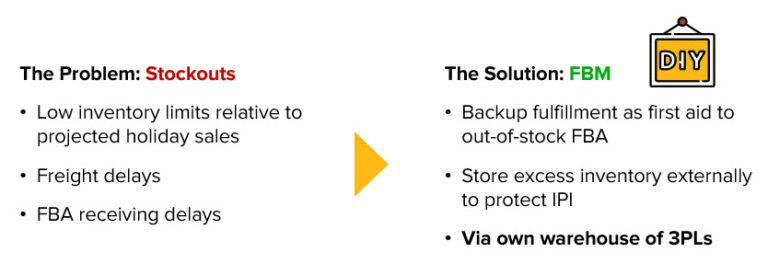
Having backup Fulfillment by Merchant for your Amazon FBA listings will first and foremost ensure that you don’t go out of stock. If you see inventory levels getting low for a hot seller in FBA, you can simply turn off the FBA listing and turn on the FBM listing. You’ll pick up selling right where you left off, and crucially you’ll avoid the disastrous cycle triggered by stockouts.
Want to learn your options and best practices for Amazon FBA? Read all about alternatives to Amazon FBA in our helpful guide.
Wrapping Up
The new holiday selling season is the entirety of Q4, and if your operations and advertising strategy are ready the moment the calendar hits October, you can win extra profitable revenue while your competitors lag.
Your more aggressive early advertising will be more efficient, as there will be relatively fewer dollars competing for your keywords. Meanwhile, you can beat the worst of carrier surcharges to prevent fulfillment from eating up your margin.
SellerApp’s powerful automation tools can keep your advertising strategy nimble and continually learning to ensure that you’re staying one step ahead of the competition.
Cahoot’s nationwide eCommerce fulfillment network will ensure that your holiday season stays on track with affordable 1- and 2-day delivery, even if FBA limits are doing their best to keep you from reaching your goals.
Speaker Bios

Manish Chowdhary, Founder & CEO, Cahoot
Manish Chowdhary is the founder and CEO of Cahoot, the world’s first peer-to-peer order fulfillment network where merchants collaborate to increase their sales and margins by offering profitable one-day and two-day free shipping to customers nationwide. Manish has founded multiple industry-leading companies starting from his dorm room at the University of Bridgeport, CT. Manish’s specialties include e-commerce strategy, business methods innovation, supply chain and logistics optimization, and he holds 10 U.S. patents for his inventions. He has been featured in The New York Times, Forbes, Internet Retailer, and many other leading publications. Manish is a 40 Under 40 Competition Winner and holds an Honorary Doctorate, the highest honor from his alma mater, University of Bridgeport, CT.

Dilip Vamanan, Co-Founder, SellerApp
Dilip Vamanan is the Co-Founder of SellerApp, a leading data analytics platform for Amazon sellers to scale their businesses and drive maximum ROI. A speaker at multiple renowned conferences like GMIC China, GMGC Malaysia, etc., he has over 13 years of experience in product development and global consulting and management. His current role and broad work experience in e-Commerce intelligence have enabled him to help Amazon sellers of all levels grow their business and gain a competitive edge in the industry.
